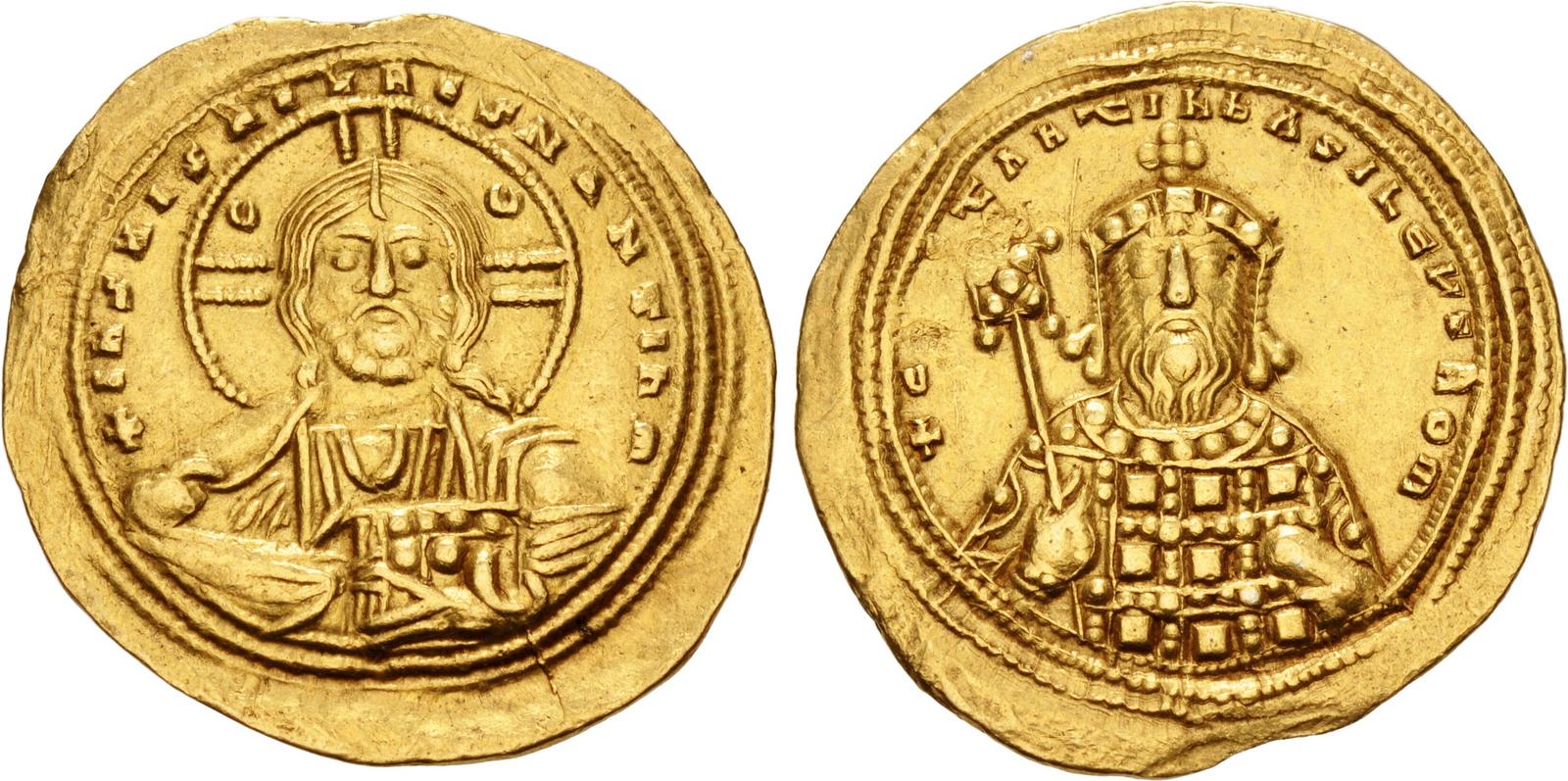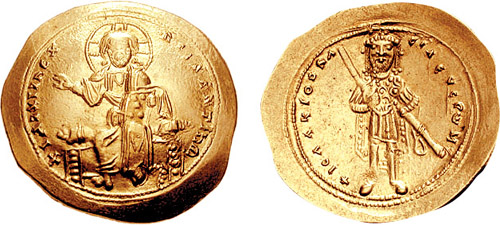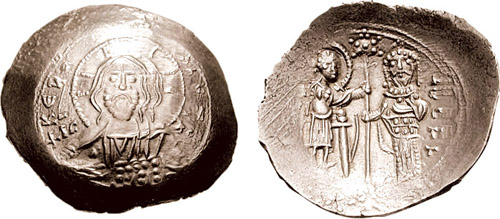Histamenon Of Basil II on:
[Wikipedia]
[Google]
[Amazon]
 ''Histamenon'' (, ''hist├Īmenon ├│misma' ) was the name given to the gold
''Histamenon'' (, ''hist├Īmenon ├│misma' ) was the name given to the gold
 Initially, the two coins were virtually indistinguishable except in weight. During the later reign of
Initially, the two coins were virtually indistinguishable except in weight. During the later reign of
 Starting with Michael IV, who was a former money lender, the gold content began to be increasingly lowered and the coins debased. After a period of relative stability in ŌĆō1070, the gold content declined dramatically in the disastrous 1070s and 1080s. The '' michaelata'' of
Starting with Michael IV, who was a former money lender, the gold content began to be increasingly lowered and the coins debased. After a period of relative stability in ŌĆō1070, the gold content declined dramatically in the disastrous 1070s and 1080s. The '' michaelata'' of
 ''Histamenon'' (, ''hist├Īmenon ├│misma' ) was the name given to the gold
''Histamenon'' (, ''hist├Īmenon ├│misma' ) was the name given to the gold Byzantine
The Byzantine Empire, also known as the Eastern Roman Empire, was the continuation of the Roman Empire centred on Constantinople during late antiquity and the Middle Ages. Having survived the events that caused the fall of the Western Roman E ...
'' solidus'' when the slightly lighter ''tetarteron
The ''tetarteron'' (, "quarter oin) was a Byzantine Empire, Byzantine term applied to two different coins, one gold circulating from the 960s to 1092 in parallel to the ''histamenon'', and one copper used from 1092 to the second half of the 13t ...
'' was introduced in the 960s. To distinguish the two, the ''histamenon'' was changed in form from the original ''solidus'', becoming wider and thinner, as well as concave ( scyphate) in form. Later usually shortened to ''stamenon'' (), it was discontinued after 1092. In the 12th and 13th centuries, the name ''stamenon'' came to be applied to the concave billon and copper
Copper is a chemical element; it has symbol Cu (from Latin ) and atomic number 29. It is a soft, malleable, and ductile metal with very high thermal and electrical conductivity. A freshly exposed surface of pure copper has a pinkish-orang ...
''trachea
The trachea (: tracheae or tracheas), also known as the windpipe, is a cartilaginous tube that connects the larynx to the bronchi of the lungs, allowing the passage of air, and so is present in almost all animals' lungs. The trachea extends from ...
'' coins.
Establishment
Ever since EmperorConstantine I
Constantine I (27 February 27222 May 337), also known as Constantine the Great, was a Roman emperor from AD 306 to 337 and the first Roman emperor to convert to Christianity. He played a Constantine the Great and Christianity, pivotal ro ...
() introduced it in 309, the Byzantine Empire's main coinage had been the high-quality '' solidus'' or ''nomisma
''Nomisma'' () was the ancient Greek word for "money" and is derived from nomos () meaning "'anything assigned,' 'a usage,' 'custom,' 'law,' 'ordinance,' or 'that which is a habitual practice.'"The King James Version New Testament Greek Lexicon; ...
'', which had remained standard in weight (4.55 gram
The gram (originally gramme; SI unit symbol g) is a Physical unit, unit of mass in the International System of Units (SI) equal to one thousandth of a kilogram.
Originally defined in 1795 as "the absolute Mass versus weight, weight of a volume ...
s) and gold
Gold is a chemical element; it has chemical symbol Au (from Latin ) and atomic number 79. In its pure form, it is a brightness, bright, slightly orange-yellow, dense, soft, malleable, and ductile metal. Chemically, gold is a transition metal ...
content (24 carats) through the centuries. Emperor Nikephoros II Phokas
Nikephoros II Phokas (; ŌĆō 11 December 969), Latinized Nicephorus II Phocas, was Byzantine emperor from 963 to 969. His career, not uniformly successful in matters of statecraft or of war, nonetheless greatly contributed to the resurgence of t ...
(), however, introduced a new coin, the '' omismatetarteron'' ("quarter oin) which was 2 carats (i.e. about 1Ōüä12, despite its name) lighter than the original ''nomisma''. The latter now became known as the ''histamenon'', from the Greek verb , "to stand up", implying that these followed the traditional standard. The reasons for this change are not clear; Byzantine chroniclers, however, suggest fiscal motives, reporting that Nikephoros collected the taxes as before in the ''histamenon'' while paying back with the ''tetarteron'', which was officially rated as equal in value to the full-weight coin.
 Initially, the two coins were virtually indistinguishable except in weight. During the later reign of
Initially, the two coins were virtually indistinguishable except in weight. During the later reign of Basil II
Basil II Porphyrogenitus (; 958 ŌĆō 15 December 1025), nicknamed the Bulgar Slayer (, ), was the senior Byzantine emperor from 976 to 1025. He and his brother Constantine VIII were crowned before their father Romanos II died in 963, but t ...
(), the ''tetarteron'' began to be minted in a thicker and smaller form, while the ''histamenon'' became correspondingly thinner and wider. Only during the sole rule of Constantine VIII () did the two coins become iconographically distinct as well. By the mid-11th century, the ''tetarteron'' measured 18 mm wide and its weight apparently standardized at 3.98 gram
The gram (originally gramme; SI unit symbol g) is a Physical unit, unit of mass in the International System of Units (SI) equal to one thousandth of a kilogram.
Originally defined in 1795 as "the absolute Mass versus weight, weight of a volume ...
s, i.e. three carats less than the ''histamenon'' or ''stamenon'' (a name first attested in 1030), which now measured 25 mm in diameter (as opposed to 20 mm for the original ''solidus''). In addition, under Michael IV the Paphlagonian
Michael IV the Paphlagonian (; c. 1010 ŌĆō 10 December 1041) was Byzantine Emperor from 11 April 1034 to his death on 10 December 1041.
The son of a peasant, Michael worked as a money changer until he was found a job at court by his brother ...
(), it began to be minted in a slightly concave (scyphate) form, possibly to increase the thin coin's strength and to make it less easily bent. Flat coins were still struck at times, but scyphate ones came to predominate from Constantine IX
Constantine IX Monomachos (; 980/ 1000
ŌĆō 11 January 1055) reigned as Byzantine emperor from June 1042 to January 1055. Empress Zo├½ Porphyrogenita chose him as a husband and co-emperor in 1042, although he had been exiled for conspiring again ...
() on and became standard under Isaac I Komnenos
Isaac I Komnenos or Comnenus (; ŌĆō 1 June 1060) was Byzantine emperor from 1057 to 1059, the first reigning member of the Komnenian dynasty.
The son of the general Manuel Erotikos Komnenos, he was orphaned at an early age, and w ...
(). These concave coins were known as ''histamena trachea'' or simply ''trachea'' (ŽäŽü╬▒Žć╬Ł╬▒, "rough, uneven") from their shape.
Debasement and abolition
 Starting with Michael IV, who was a former money lender, the gold content began to be increasingly lowered and the coins debased. After a period of relative stability in ŌĆō1070, the gold content declined dramatically in the disastrous 1070s and 1080s. The '' michaelata'' of
Starting with Michael IV, who was a former money lender, the gold content began to be increasingly lowered and the coins debased. After a period of relative stability in ŌĆō1070, the gold content declined dramatically in the disastrous 1070s and 1080s. The '' michaelata'' of Michael VII Doukas
Michael VII Doukas or Ducas (), nicknamed Parapinakes (, , a reference to the devaluation of the Byzantine currency under his rule), was the senior Byzantine emperor from 1071 to 1078. He was known as incompetent as an emperor and reliant on ...
() still contained some 16 carats of gold, but by the time of Alexios I Komnenos
Alexios I Komnenos (, ŌĆō 15 August 1118), Latinization of names, Latinized as Alexius I Comnenus, was Byzantine Emperor, Byzantine emperor from 1081 to 1118. After usurper, usurping the throne, he was faced with a collapsing empire and ...
(), the ''nomismata'' struck contained almost no gold at all. Thus, in 1092, Alexios I carried out a comprehensive monetary reform, replacing among others the debased gold coins, both the ''histamenon'' and the ''tetarteron'', with a new high-quality gold issue, the ''hyperpyron
The ''hyperpyron'' (, ''n├│misma hyp├®rpyron'' ) was a Byzantine coin in use during the late Middle Ages, replacing the '' solidus'' as the Byzantine Empire's standard gold coinage in the 11th century. It was introduced by emperor Alexios I Komneno ...
''.
Henceforth, and for the duration of the Komnenian monetary system (12thŌĆō13th centuries), the term ''stamenon'', due to its association with scyphate coins, came to be applied as a blanket term to the similarly concave billon and copper coins (''trachea
The trachea (: tracheae or tracheas), also known as the windpipe, is a cartilaginous tube that connects the larynx to the bronchi of the lungs, allowing the passage of air, and so is present in almost all animals' lungs. The trachea extends from ...
'') issued by the Byzantine Empire.
References
Sources
* * * * {{Byzantine coinage Gold coins Coins of the Byzantine Empire